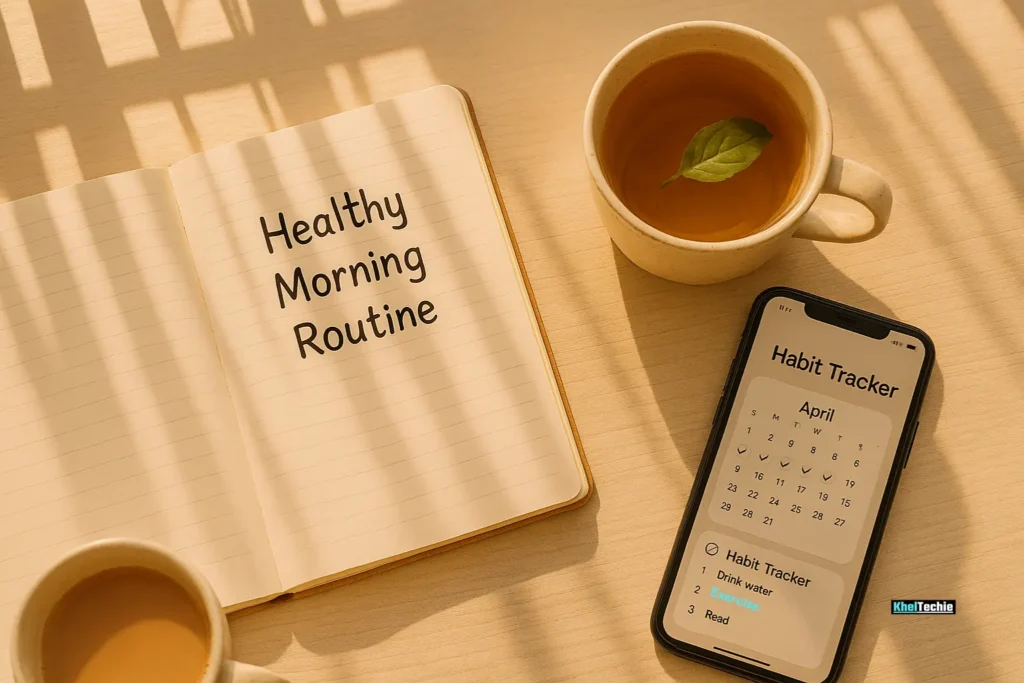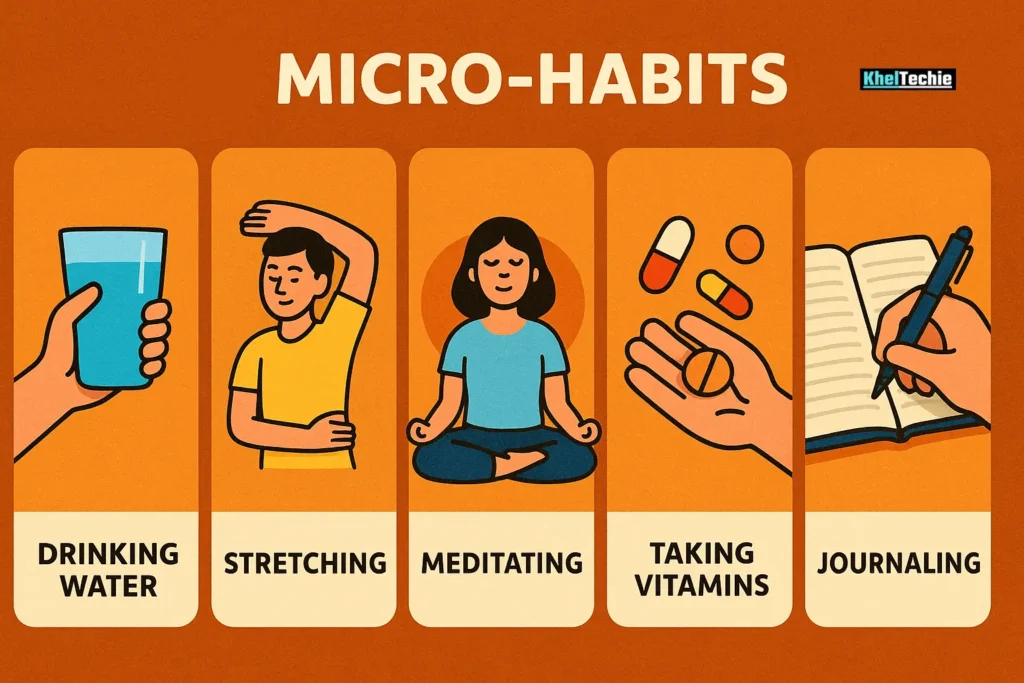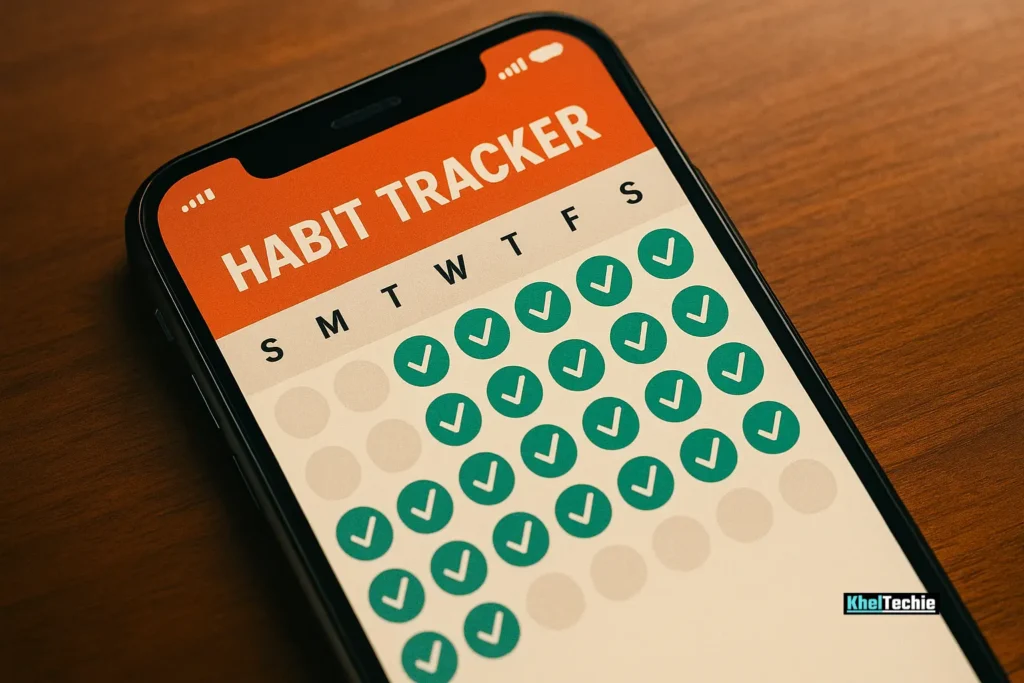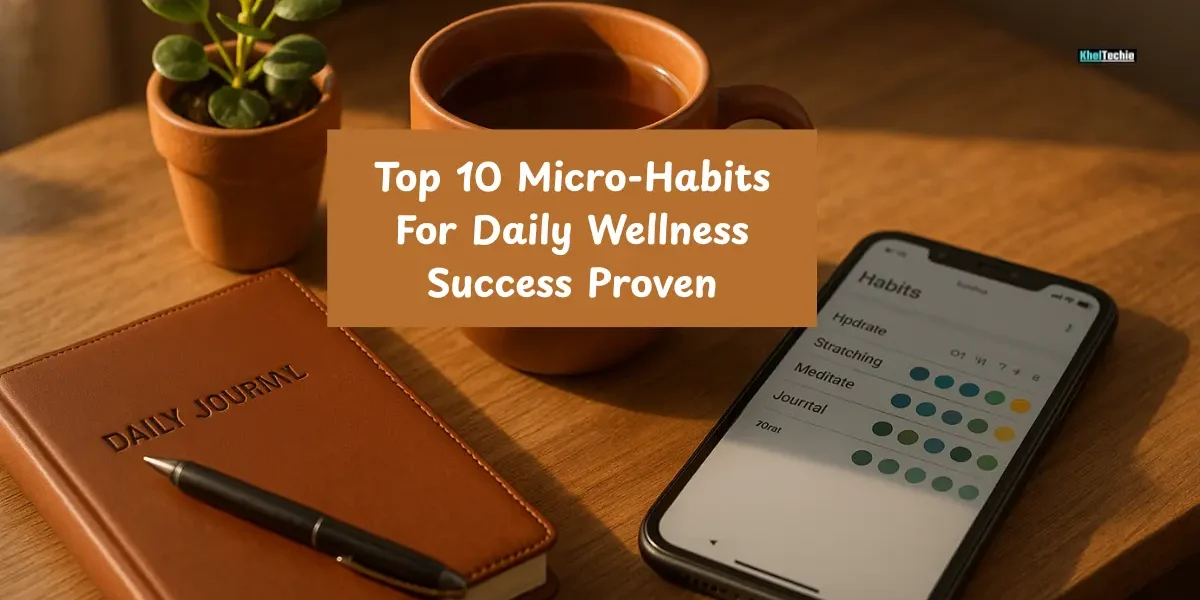Top 10 Micro-Habits for Daily Wellness Success: Tiny Steps, Big Results
The Power of Tiny Changes
Ever felt like you’re doing everything right but still not seeing the results in your wellness journey? You’re not alone, Many people struggle with overwhelming goals like lose 20 pounds or meditate every day, only to give up within a week.
Here’s the truth, big transformations come from small, consistent actions, what experts call micro-habits.
In this article, we’ll explore how micro-habits for daily wellness success can reshape your life without drastic overhauls. Whether you’re looking to improve mental clarity, boost energy levels, or simply feel more balanced, these tiny shifts will help you succeed, one small step at a time.
Also read – How to Create a Simple Morning Workout Routine

What Are Micro-Habits for Daily Wellness Success?
Let’s break it down.
Micro-Habits Defined
A micro-habit is a tiny, manageable action that takes less than two minutes to complete but leads to long-term positive change when repeated consistently.
Think of them like seeds, they seem small and insignificant on their own, but if planted regularly and nurtured, they grow into something powerful.
Example: Drinking one extra glass of water each morning is a micro-habit. Over time, it supports hydration, digestion, and even clearer skin.
Why Focus on Wellness?
Wellness isn’t just about fitness or diet, it’s a holistic approach to living well. It includes:
- Physical health
- Mental clarity
- Emotional balance
- Social connection
- Spiritual alignment
And guess what? You don’t need to overhaul your entire life overnight to achieve it. You just need consistent, bite-sized actions.
Why Micro-Habits for Daily Wellness Success Matter
1. They Fit Into Real Life
We live busy lives, trying to adopt major lifestyle changes all at once often leads to burnout. But micro-habits are designed to fit into your current routine without disrupting it.
Start by attaching a new habit to an existing one. For example, do five deep breaths after brushing your teeth.
2. Science Backs Them Up
Research shows that small, repeated behaviors create lasting neural pathways in the brain. This is called habit stacking, and it makes consistency easier over time.
A study published in the Healthline found that it takes an average of 66 days for a new behavior to become automatic, not the mythical 21 days everyone talks about.
3. They Build Confidence
Each tiny win gives your brain a dopamine hit, a natural reward system that motivates you to keep going. This builds momentum and self-trust.
Imagine starting with just one minute of stretching every morning. After a week, you might find yourself wanting to stretch longer, naturally!

Process For Building Your Micro-Habit Routine
Creating a successful micro-habit plan doesn’t have to be complicated. Here’s how to do it:
Step 1: Identify Your Goal
What area of wellness do you want to improve?
- Better sleep?
- More energy?
- Reduced stress?
- Improved posture?
Choose one focus area to start.
Step 2: Find a Tiny Habit That Supports It
Look for a simple, actionable habit that takes less than two minutes.
| Goal | Suggested Micro-Habit |
|---|---|
| Better Sleep | Put on sleep mask at bedtime |
| More Energy | Drink a glass of water first thing |
| Less Stress | Do 3 deep breaths before meals |
| Posture Improvement | Sit up straight while sipping coffee |
Step 3: Attach It to an Existing Routine
This is key for habit formation. Use the “After I [existing habit], I will [new habit]” formula.
Example: After I brush my teeth, I will do three squats.
Step 4: Track Your Progress
Use a habit tracker app or a simple checklist. Visual progress keeps motivation high.
Step 5: Review Weekly
Ask yourself:
- Did I stick with it?
- Was it too easy or too hard?
- Can I build on it?

Top 10 Micro-Habits for Daily Wellness Success
Now let’s dive into the Top 10 Micro-Habits for Daily Wellness Success , complete with actionable steps and expert-backed insights.
| Habit | Micro-Habit | Description |
|---|---|---|
| 1 | Morning Hydration | Start your day with a glass of water |
| 2 | Deep Breathing | Take 3 deep breaths before meals |
| 3 | Movement Breaks | Walk for 2 minutes every hour |
| 4 | Gratitude Journaling | Write down 1 thing you’re grateful for |
| 5 | No-Screen Mornings | Avoid phones for the first 30 minutes |
| 6 | Stretch First Thing | Do a 2-minute stretch routine |
| 7 | Mindful Eating | Eat slowly, chewing each bite thoroughly |
| 8 | Hydrate Throughout the Day | Sip water consistently instead of chugging |
| 9 | Evening Wind-Down Ritual | Turn off screens 30 minutes before bed |
| 10 | Reflect Before Bed | Ask yourself, “What went well today?” |
Let’s break each one down.
1. Morning Hydration: Start Your Day Right
Action:
Drink a full glass (about 8 oz) of water as soon as you wake up.
Why It Works:
Your body is dehydrated after sleep, Replenishing fluids jumpstarts your metabolism, improves digestion, and boosts alertness.
How to Build It:
- Place a glass of water beside your bed.
- Use a marked bottle to track intake.
- Add lemon or mint for flavor if plain water is boring.
2. Deep Breathing Before Meals
Action:
Take 3 slow, deep breaths before eating.
Why It Works:
This simple act activates the parasympathetic nervous system, which helps your body digest food better and reduces stress.
How to Build It:
- Set a reminder on your phone before meal times.
- Pair it with an existing habit (e.g., sitting down to eat).
- Use a breathing app like Calm or Insight Timer for guidance.
3. Movement Breaks Every Hour
Action:
Walk around or do light stretches for 2 minutes every hour.
Why It Works:
Prolonged sitting increases the risk of heart disease and obesity. Even short bursts of movement improve circulation and mental clarity.
How to Build It:
- Use a standing desk timer or app.
- Schedule walking meetings.
- Do squats while waiting for coffee to brew.
4. Gratitude Journaling: One Line a Day
Action:
Write down one thing you’re grateful for each day.
Why It Works:
Gratitude shifts your mindset from scarcity to abundance. Studies show it reduces anxiety and enhances emotional resilience.
How to Build It:
- Keep a small notebook by your bed.
- Use voice memos if writing isn’t your style.
- Make it part of your bedtime routine.
5. No-Screen Mornings
Action:
Avoid checking your phone for the first 30 minutes after waking.
Why It Works:
Starting your day with social media or emails sets a reactive tone. Giving yourself space to think and breathe builds calm and focus.
How to Build It:
- Put your phone in another room overnight.
- Replace scrolling with journaling or stretching.
- Use an old-school alarm clock.
6. Stretch First Thing
Action:
Do a quick 2-minute stretch routine when you wake up.
Why It Works:
Stretching increases blood flow, eases muscle tension, and prepares your body for movement.
Focus on major areas like hamstrings, shoulders, and lower back.
How to Build It:
- Follow a YouTube video for guided stretching.
- Use a yoga strap or towel if flexibility is limited.
- Link it to your morning hydration habit.
7. Mindful Eating
Action:
Eat slowly, chew thoroughly, and savor each bite.
Why It Works:
Mindful eating prevents overeating, aids digestion, and makes meals more enjoyable.
How to Build It:
- Put utensils down between bites.
- Turn off distractions during meals.
- Practice portion control using smaller plates.
8. Hydrate Throughout the Day
Action:
Sip water consistently instead of waiting until you’re thirsty.
Why It Works:
Thirst is a sign of early dehydration. Staying ahead of it keeps energy levels steady and brain function sharp.
How to Build It:
- Carry a reusable water bottle.
- Set hourly reminders.
- Infuse water with fruits for natural flavor.
9. Evening Wind-Down Ritual
Action:
Turn off all screens 30 minutes before bed.
Why It Works:
Blue light suppresses melatonin production, making it harder to fall asleep. A calming pre-sleep ritual improves sleep quality.
How to Build It:
- Read a physical book or listen to calming music.
- Try gentle yoga or meditation.
- Dim the lights and set a consistent bedtime.
10. Reflect Before Bed
Action:
Ask yourself, “What went well today?”
Why It Works:
Ending your day with reflection fosters self-awareness, appreciation, and motivation.
Positive psychology suggests that focusing on successes rewires the brain to look for good things.
How to Build It:
- Say it out loud or write it down.
- Share it with a partner or friend.
- Combine it with gratitude journaling.

Common Mistakes to Avoid and How to Fix Them
Even the best plans can fail if you make these common mistakes:
❌ 1. Trying Too Many Habits at Once
Your brain has limited willpower, Start with one or two micro-habits max.
❌ 2. Setting Unrealistic Expectations
Remember, it’s about consistency, not perfection. Missing a day won’t ruin your progress.
❌ 3. Ignoring Environment Cues
If you want to drink more water, leave a bottle on your desk. Make the habit visible and accessible.
❌ 4. Skipping the Reward System
Celebrate small wins! Give yourself a pat on the back or treat yourself after a week of consistency.
Personal Story: From Burnout to Balance
Let me share my girlfriend’s experience.
Three years ago, she was burnt out from work, stressed, and constantly tired. She tried every quick fix, detoxes, extreme diets, intense workouts, but nothing stuck.
Then She discovered micro-habits.
She started with just:
- One glass of lemon water in the morning
- Five minutes of meditation before bed
- A 10-minute walk during lunch breaks
Within 8-9 weeks, She and I both noticed:
- More energy
- Fewer anxiety spikes
- Better sleep
- A calmer mindset
This wasn’t magic, it was science + consistency.
Also read – Evening Habits for Better Sleep and Weight Loss

Conclusion: Start Small, Think Big
Micro-habits for daily wellness success aren’t flashy or dramatic, but they’re powerful. They’re the quiet forces behind long-term transformation, built one tiny choice at a time.
So, what will your first micro-habit be?
Drop a comment below or share this post with someone who needs a gentle nudge toward wellness. Let’s grow together, one small step at a time.
FAQs
How long does it take to form a micro-habit?
Research suggests it takes about 21 to 66 days to form a new habit, depending on complexity and consistency
What Are the Best Times to Practice Micro-Habits?
Morning routines work best since your willpower is strongest early in the day. However, any time that fits your schedule is good — consistency matters more than timing.
Can Micro-Habits Help With Weight Loss?
Yes! For example:
Drink water before meals
Take a 5-minute walk after dinner
Use smaller plates
These small changes add up over time.
How Do I Stay Motivated With Micro-Habits?
Track your progress visibly (like a calendar), pair habits with enjoyable activities, and remind yourself why the habit matters to you.
Should I Track My Micro-Habits Every Day?
Yes — tracking increases accountability and helps reinforce the habit loop. Use apps like Streaks , HabitBull , or even a paper checklist.
Can I Stack Multiple Micro-Habits Together?
Absolutely! Habit stacking is a powerful technique. For example:
After I pour my morning coffee, I will do 10 jumping jacks.
After I finish lunch, I will take a 3-minute walk.
How Do Micro-Habits Improve Mental Health?
They reduce overwhelm, increase feelings of control, and release dopamine through small wins. Over time, this builds resilience and confidence.
Can micro-habits replace traditional wellness routines?
While they can significantly improve well-being, micro-habits are best used to complement, not replace, comprehensive wellness plans.
Are micro-habits enough for overall wellness?
They’re a great foundation. Combine them with other strategies like nutrition, exercise, and sleep hygiene for best results.
Can micro-habits really make a difference?
Yes! Because they’re so small and easy, they stick better than drastic lifestyle changes. Over time, they compound into meaningful results.





Pingback: Microwalking For Health Insurgence: Transforming Wellness
Pingback: DIY Herbal Teas For Wellness : Brew Natural Health At Home
Pingback: Top 11 Indoor Plants For Clean Air: Breathe Like Magic!
Pingback: How To Build A Healthy Skincare Routine In 6 Simple Steps
Pingback: Revitalize Naturally: Benefits Of Cold Showers For Wellness
Pingback: Desk To Dynamic: Quick Mobility Routines For Remote Workers
Pingback: How To Start A Gratitude Journal In 2025 For Mental Wellness
Pingback: How To Build A Sustainable Meditation Habit
Pingback: How To Master The 8+8+8 Rule: Balance Work, Life & Sleep